
The Objective
AegeanTec’s first JJ-CCR diving trip in Greece fulfilled a long held ambition. What better way to kickstart a new tradition than to combine it with diving a WWI wreck? Especially one that had been visited only once before and that constituted an absolute time capsule from the evening of August 2, 1917!
The event was organized in February, and we teamed up with our associates, the UFR Team of Vasilis Mentogiannis, who immediately embraced the idea, as he was the first diver to have dived the HMS Ermine. In addition, we asked for the support of Kostas Katsioulis who was keen to assist and had both his dive center, Northern Greece Underwater Explorers, and the Oceanic Diving Center in Nikiti working together to make this possible. The local authorities in Stratoni and Olympiada, along with the Hellas Gold SA, and the Hippocampus Marine Institute also backed our efforts to highlight this unique wreck. Mr. G. Karelas was with us to provide information based on his vast experience, not only in diving but also in researching historic wrecks.
The invitation to the JJ-CCR diving community was posted on social media, and the event was fully booked within the first week! Ian France, Tim Cutter, and Yana Stashkevich were the first ones to respond, as they had participated in our Sifnos Wellington project already. In addition, Gavin Hulmston from the UK and Ali Shah from Houston, Texas joined us. As the operation was in a remote area, we invited Dr. Heinke Teichman from Germany to participate and be our medic. And, of course, Vasilis Spyropoulos was the diver in charge of producing the photos for the mission. He worked closely with Gavin, who was in control of the video recording.

HMS Ermine
The HMS ERMINE was a British Steam Passenger Ferry of 1,836 tons built in 1912 by Fairfied, Govan, Yard No. 486 for G & J Burns Ltd, Glasgow. She was initially used for transporting passengers and animals, plus making postal deliveries between Scotland, Ireland, and England. In 1915, she was requisitioned by the Admiralty for the purpose of transporting troops, equipment, and animals. She was a twin-screw vessel powered by two sets of four-cylinder triple expansion engines.
On Thursday, August 2, 1917, the HMS Ermine was in the Port of Stavros waiting to receive her last cargo later that evening in order to sail to the port of Thessaloniki, carrying 56 passengers and her crew of 30. Those were the days of WWI when the little port of Stavros in the North of Greece was used extensively by the Entente forces as a mid-station between the ports of Moudros in Lemnos Island and Thessaloniki.
A few days earlier, the German U boat UC-23 had arrived at the Strymonic Bay and mined an area outside the bay on the course from Moudros to Thessaloniki. The experienced Captain of the U boat, Freiherr von Bothmer, placed two series of nine mines each outside the area defined by a buoy which had been placed by the English who correctly assumed that it defined the area not under the control of the English minesweepers. (Later, the Admiralty acknowledged that placing the buoy offshore the bay was a mistake.)
On the evening of August 2, 1917, HMS Ermine left the port of Stavros and crossed the safe channel that was controlled by the Admiralty and its minesweepers. However, during her journey and while offshore from Olympiada, she hit a mine on the port side of the bow and sank in just three minutes. Twenty-four people lost their lives despite the “abandon ship” order given by Captain Mathew Boban almost immediately after the vessel struck the mine.
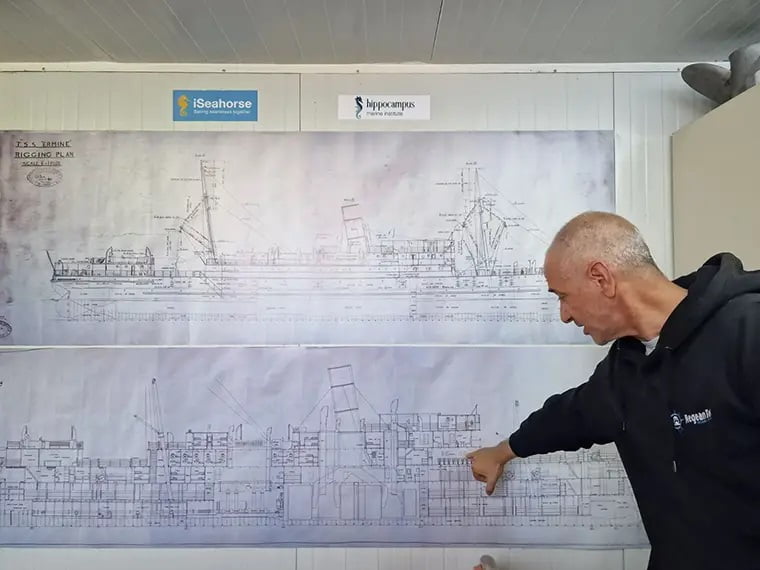
The Dives
HMS Ermine sits upright in one piece at a depth of 63 m/207 ft on the seabed of the Strymonic Bay. The waters there do not have the usual Aegean blue color, light, and clarity, as several rivers flow into the bay carrying material from the land creating a silty and dark environment underwater. The vessel has been resting on the seabed for 107 years and is completely covered by marine life and silt thus making it hard to distinguish structural details with accuracy. It is buried in the sedimentary floor of the Strymonic Bay up to the waterline, and small sections of the hull in the bow and stern area are covered with fishing nets. Numerous fishing lines run the wreck in all directions creating the perfect diver trap in these low-visibility conditions. The anchors are both in place and fully encrusted with marine life, and we had to swim close to see them standing out from both sides of the bow.
The deck and parts of the superstructure have collapsed after all these years, but the impressive funnel is still upright as a reminder that during the Gallipoli campaign this was a fine, seaworthy vessel carrying troops, equipment, animals, and ammunition. The wooden deck has been eroded away which allowed us to see inside areas of the wreck. The UFR team procured the rigging plan and the sectional elevation drawings of the HMS Ermine from the shipbuilding company of the vessel, and it helped significantly to identify various sections. The pantry and the saloon areas were exactly as the crew left them 107 years ago when they followed the captain’s orders to abandon ship. The view of the four series of stools in the saloon area where everything was covered with a thick layer of silt was an unforgettable experience for the divers.
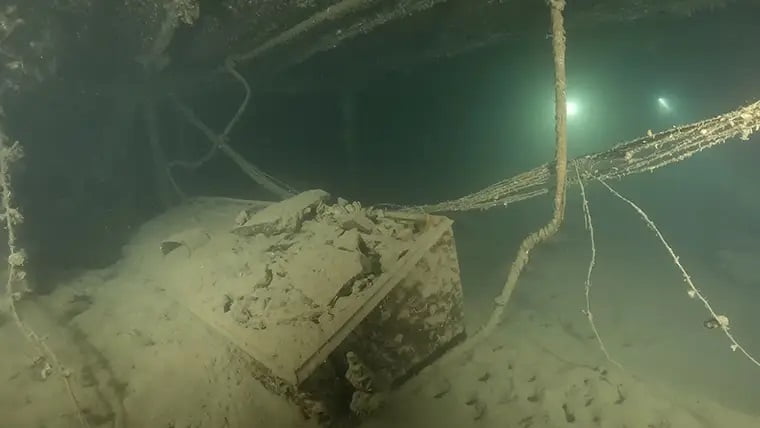
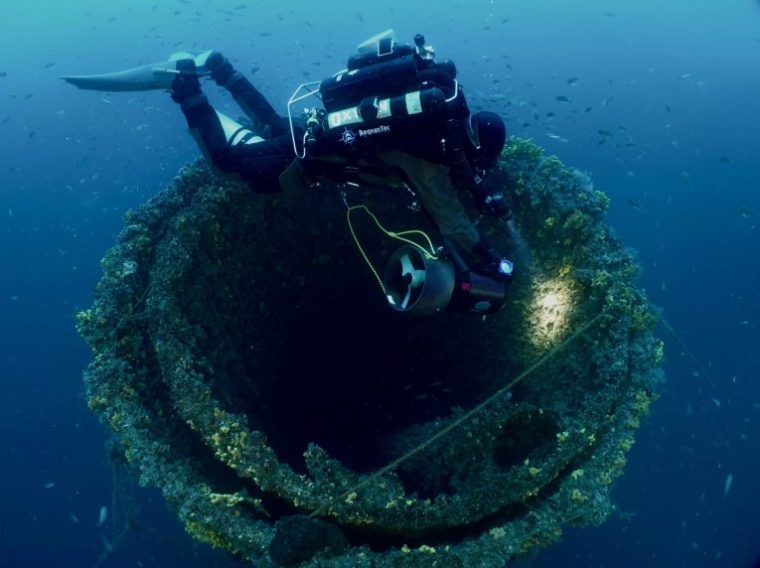
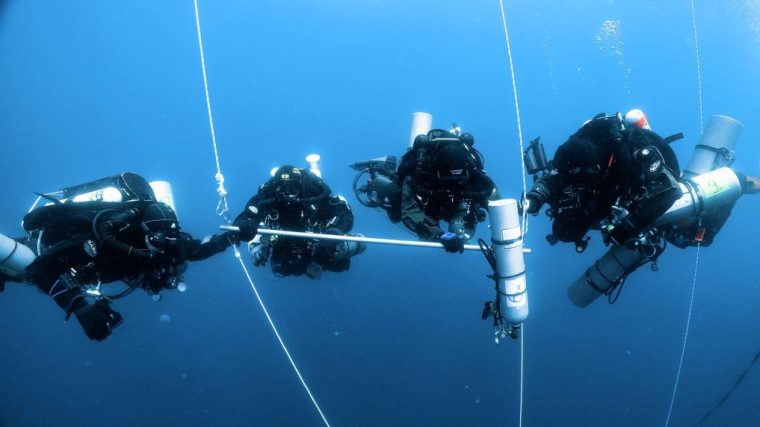
Between the frames of the deck, we could see parts of the triple expansion engine, the water heater, a staircase connecting the upper and lower engine rooms, and thick layers of deposits covering all segments of the interior. Vasilis, our photographer, located and photographed the ID plate of the shipbuilders and engine manufacturers directly below a bulkhead. This area is now fully exposed, as the deck above it is completely rotten.
On the upper deck area, all the davits point toward the outside, and the boats are missing—indicating that they had been lowered by the crew as they were abandoning the vessel. The mast in the front section has collapsed, and half of it is resting on the forward deck. The rear mast is still in place, but the thick layer of hard deposits has created a crust making it impossible to spot any details or equipment (e.g., lamps, pulleys, chains) on it. The upper section of the rudder is barely visible in the dark lower section of the stern, as a fishing net covers a big section of the hull there. The rest of the rudder and the propellers are buried deep in the sediment of the sea floor.
To ease logistics and increase safety, the divers formed two teams. The divers in the second team were in the shotline starting their descent 30 minutes after the first team left the surface. With a BT of 35 minutes, we had enough time to find the material required to document this unique wreck; however, under these visibility conditions, it was not an easy task. While we all managed to create enough material to further document this amazing wreck, special credit goes to both Vasilis and Gavin, our photographers/videographers whose jobs were tough. Also, the experienced Vasilis Mentogiannis provided surface support and sonar operation, allowing us to have a shotline and the deco station where we needed it.
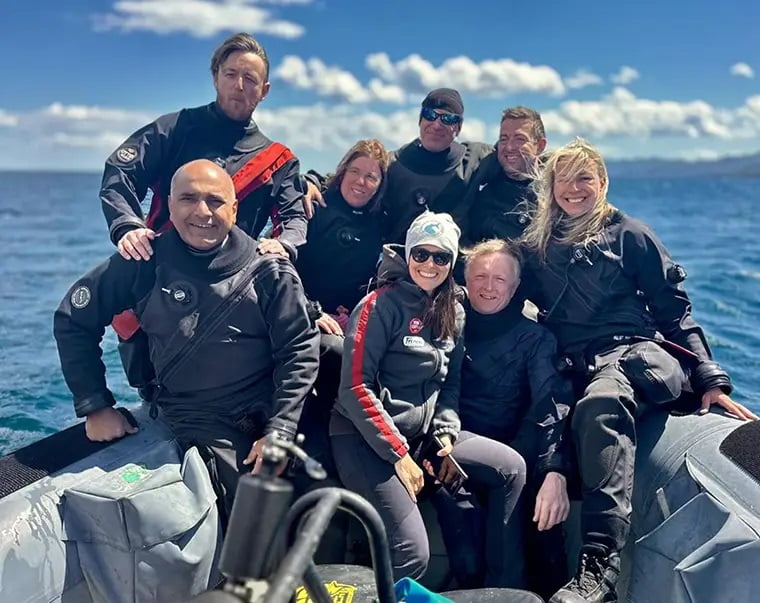
Since they were interested in our finding and keen on discovering ways to highlight the history hidden under the surface of Strymonic Bay, several local authorities and officials from the mining company, Hellas Gold SA, visited our base camp during our stay.
The divers who participated in our first JJ-CCR event in Greece gazed (literally) through the window of WWI history by diving the pristine wreck of HMS Ermine in the North of Greece. The project was a success since all team members worked together and were eager to visit this dive site to document it further for the benefit of the local community and future generations. For AegeanTec, it was mission accomplished, as we managed to organize this event not from our base off the coast of Athens, but from a remote location 600 km/370 mi away. Thanks to the support of our affiliates, positive attitudes, and excellent teamwork, we created unforgettable moments for our divers and kept them smiling throughout this expedition.
A Greek JJ-Palooza on HMS Ermine – InDEPTH (indepthmag.com)








